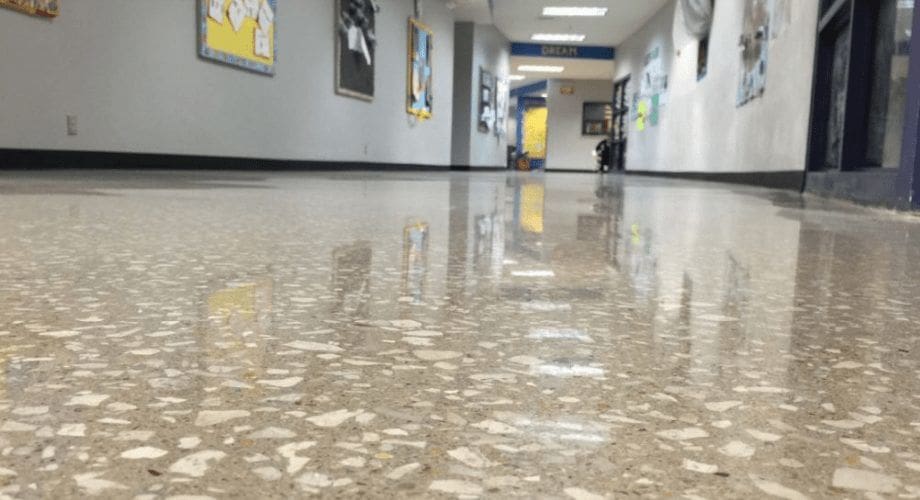What is Polished Concrete? Your Concrete Flooring Guide
Service: Concrete Resurfacing, Concrete Sealing, Polished Concrete
Polished concrete has emerged as an attractive option for residential, commercial, and industrial spaces in recent years because these floors are easy to maintain and clean, as well as being affordable when compared to other flooring options. If you are doing research into different types of flooring systems, you’re probably asking yourself: What is polished concrete?
There’s not an easy answer to this question, in part because polished concrete can mean so many things, depending on exactly what you are looking for. You could want a neutral backdrop for your next retail location so that your products take center stage. Or perhaps you’d like to mimic the look of granite to showcase cars in your showroom. Maybe you want to add a custom look by stenciling your logo into large tiles to make an impression on your customers. Homeowners often choose polished concrete if they want to get rid of the carpet and complement a modern aesthetic. The possibilities are nearly endless.
While some homeowners may decide to polish their floors, a vast majority of these projects are best left to the pros, who have the specialized tools and the experience needed to make sure you achieve your desired objectives. In this post, we’ll talk about different concrete flooring types, the process of getting polished concrete flooring, the pros and cons of polished concrete, and the different commercial polished concrete floors.
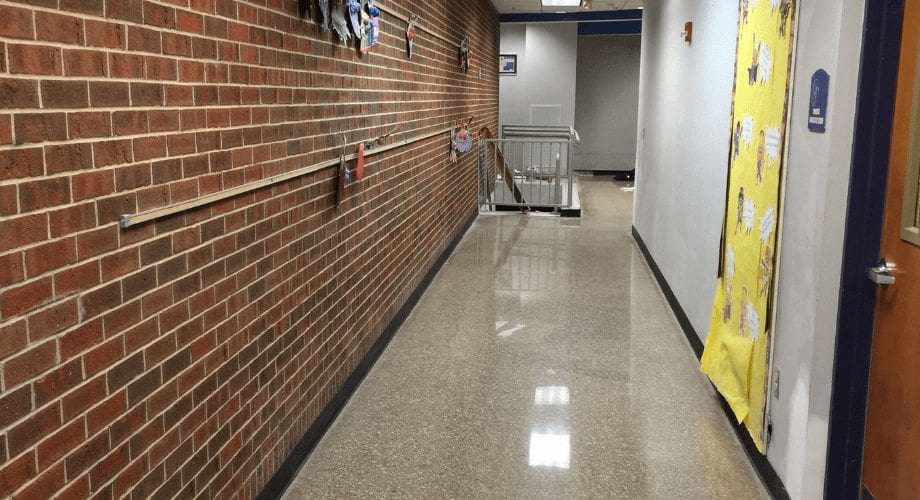

polished concrete floors pros and cons
Concrete Flooring Types: An Overview
One of the many benefits of concrete flooring is that it is very versatile. If you are still in the planning stages of your project, you probably want to know what all the different types of concrete flooring options are to make sure that polished concrete best suits your needs.
Epoxy Coated Concrete
Concrete is inherently porous, meaning it can absorb chemicals, moisture, and other materials. If you need a surface that can withstand exposure to heavy loads, stains, chemicals, and other high demands, epoxy coatings may be your best option. Although it may look like a coat of paint, epoxy flooring can be customized to meet your space’s unique demands. Take a warehouse, for example. You’ll need a flooring system that can stand up to forklifts moving back and forth all day, which is tough enough not to chip or crack under heavy pressure and that is easy to clean if oil or other materials spill during normal operations. Healthcare facilities, food processing plants, and fitness centers are other examples of environments that often have epoxy floors. In residential settings, epoxy coatings are often applied in garages for an attractive surface in spaces that are prone to oil, antifreeze, transmission fluid, and other leaks from vehicles.
If you are weighing a polished concrete vs. an epoxy floor, you’ll need to take into consideration the function of the space and whether you need a high-performance floor. In most situations, polished concrete will work just fine, particularly if you seal the surface. If you like the look of a concrete floor and don’t want an opaque overlay, you can also choose a clear epoxy coating if you think it’s worth the investment. An experienced concrete contractor can help you weigh all your options to determine what type of flooring system would work best for your project.
Polished Concrete
Schools, restaurants, distribution centers, and homes all can have polished concrete floors. A cost-effective alternative to carpeting, vinyl, wood, natural stone or tile, polished concrete is sustainable, easy to clean, and resistant to mildew, mold, mites, and other common allergens. Better yet, existing concrete in almost any condition can be resurfaced and polished to give your space a significant upgrade at a fraction of the cost of other flooring materials. Once the top layer of your floor is ground down to your desired specifications, you can finish out your project with overlays, stains, dyes, stencils, and decorative patterns or just leave a natural gray color with your desired sheen.
Stained Concrete
If you want to enhance the natural appeal of concrete and bring out rich, translucent tones, you may consider stained concrete floors for your project. Rather than sitting on top of your surface, like epoxy, concrete staining permeates below the surface, creating a unique appearance. Unlike an epoxy coating that may need to be reapplied after years of wear and tear, stains are permanent. You can choose between acid and water-based stains, and you may want to apply several different colors of stains to achieve the desired look, use both stains and dyes or create a decorative effect by using thick stains with stencils. Once you stain a floor, the color won’t chip, fade or peel away. You might stain concrete in a furniture store, a waiting room, a food hall, or a residential patio.
Sealed Concrete
As we’ve already mentioned, raw concrete is vulnerable to the absorption of moisture and chemicals. In addition, exposure to the elements, improper installation, and excessive weight can result in cracks, spalling, and other imperfections. While concrete is a long-lasting material, over time it does require upkeep. If you need to rehab an existing surface or want to add new flooring, you’ll want to apply a sealer to your surface to extend its longevity. Depending on your space, you may choose a penetrating sealer, a siloxane sealer, an acrylic sealer, a polyurethane sealer, a clear sealer, or a stamped concrete sealer. You may want to simply sell your existing floor or this may be the last step in a polished concrete or stained concrete project.
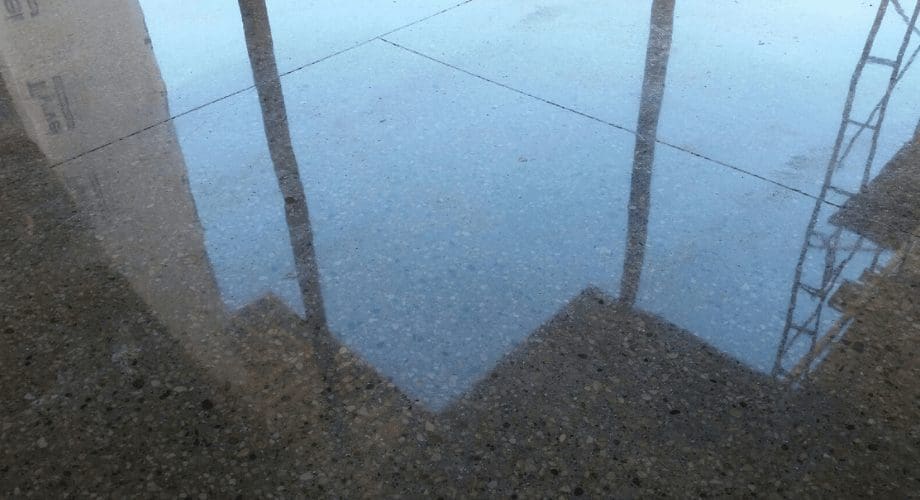

Polished Concrete flooring types
Polished Concrete Floors: Pros and Cons
If you’re leaning towards polished concrete for your space, you probably want to evaluate the advantages and disadvantages of this flooring option before you make your decision. Let’s explore some of the main reasons general contractors, property managers, business owners, and homeowners choose polished concrete or decide to go with another flooring solution.
Polished Concrete Benefits
There are many reasons we are seeing more polished floors, including that they are:
Cost-Effective
If you choose to work with your existing concrete slab, you won’t need to pay for tile, wood, linoleum, carpet, or a long list of other available floor coverings. Since polished concrete is so durable, you also won’t need to worry about the cleaning, repair, or replacement expenses that might be associated with other surfaces, including needing to have the carpets steam cleaned, hardwood floors waxed, or chipped ceramic tiles swapped out.
Long-Lasting
Simply put, polished concrete is difficult to damage. While a variety of factors can influence the service life of your floors, polished concrete should last at least 20 years, and can last a lifetime, with proper care and maintenance.
Easy To Maintain
Generally speaking, you’ll only need to use a dust mop or broom to keep your polished concrete floors free of dirt and other types of debris. Weekly, a damp mop will remove any scuffs, smudges, and watermarks and restore the gloss of your surface. For high-traffic facilities, less time cleaning means less downtime and increased productivity.
Versatile
The design opportunities are nearly limitless with concrete floors. You can combine any number of stains, dyes, and decorative elements for a unique look that perfectly suits your desired aesthetic.
Durable
Unlike other floor types, polished concrete will not chip or scratch under normal conditions. This surface works well in spaces with heavy equipment and foot traffic. Under demanding circumstances, coatings can make your concrete more resilient to different types of damage.
Slip Resistant
In commercial settings, you can avoid injuries and falls by adding a non-slip epoxy coating to your surface. Other coatings can protect your floor from chemicals, heat, static, moisture, and other contaminants.
Attractive
While raw concrete may be a blank canvas, you can’t compare the aesthetics of a concrete slab to a polished concrete floor. While you can choose from any degree of sheen, many home and business owners prefer more reflective surfaces, which help brighten up your space, thereby reducing the amount you spend on utilities. Whether you choose an understated color or invest in an elaborate pattern, you’ll get a visually appealing end product.
Environmentally Friendly
No hazardous coatings, cleaners, or adhesives are needed to protect or maintain polished concrete, depending on your choice of coatings and sealants. In most cases, polished concrete projects qualify for LEED certification.
Exposed Aggregate Levels in Polished Concrete Floors
The amount of concrete material that has been removed from the concrete slab’s surface distinguishes the three basic types of polished concrete floor finishes. The distinct types are known as cream polished, salt and pepper polished concrete floors, and exposed aggregate concrete floors. Below, we will explain some of the differences in the levels of exposed aggregate so you may choose the right floor for your next project.
Cream Polished Concrete Floors
A cream polished concrete floor is a floor with a freshly poured concrete surface that has been polished. Cream polished floors are not cut, and little cream is removed from the surface of the floor. As a result, the finish and trowel marks will be noticeable giving the surface a marbled appearance. This is one of the most common forms of polished concrete used in new construction.
Advantages of Cream Polished Concrete
- Usually fast to install
- The cost-effective option for polished concrete floors
- Natural, gray appearance
- Produces a high gloss finish with proper mix design
Disadvantages of Cream Polished Concrete
- Limited to the flatness of the floor finish
- Sometimes has low spots from the lack of grinding
Salt and Pepper Polished Concrete Floor
The surface of a salt and pepper finished floor is ground to expose the small fine aggregate in the concrete floor. This finish is most common in commercial and industrial settings due to the need to achieve a flatter floor finish. It is also installed in residential applications, but usually, when there is existing flooring it must be removed.
Advantages of Salt and Pepper Polished Concrete
- Typically, a flatter floor is achieved
- Used in commercial and residential construction
- Can produce many from low to high gloss if desired
- Removes imperfections and some high spots from the slab
Disadvantages of Salt and Pepper Polished Concrete
- Takes longer to Install
- The consistency in aggregate exposure depends on the finish
- Usually cost more per square foot
Exposed Aggregate Polished Concrete Floor
An exposed aggregate polished concrete floor is heavily ground to expose the large aggregates in a concrete floor. This exposed polished concrete surface is often installed in residential applications prior to framing. Slabs that have a good mix design and sack mix are good candidates for this application. Concrete foundations that are too soft and porous may not produce the desired results and tend to have many voids that will require grouting. Because of this, the price for exposed aggregate floors is some of the most expensive when it comes to concrete flooring.
Advantages of Exposed Aggregate Polished Concrete
- Very flat surface from the heavy grinding
- Looks like a Terrazzo
- Good for commercial or residential projects
- Can produce many from low to high gloss if desired
- Unique to each concrete pour
Disadvantages of Exposed Aggregate Polished Concrete
- Takes longer to install these floors
- Usually needs a grouting step
- One of the most expensive concrete flooring options
- Could have screed lines or aggregate voids from concrete finishers
Cutting with Diamond Tooling
Floors that need some type of removal, floor flattening, or aggregate exposure, are cut with specific products known as diamond tooling. This tooling will attach under concrete grinders and aid in the bulk of grinding and removal for various situations. Lower grits around 20/30 are used for heavy grinding and removal, while higher grits like 120/150 are used as transitional diamonds before polishing. These metal bond diamonds are required for aggregate exposure, floor flattening, and mastic removal before a floor can be polished.
Understanding Concrete Polishing Grits
When polishing concrete, grits are referred to as the benchmark for smoothness and light reflection. Lower grits usually produce a soft and less reflective look. The higher the grit, the smoother and more reflective a polished concrete floor will be. The finish grits are usually between 100 and 3000 grits, with higher numbers producing a higher gloss.
- 100-200 grit – Low gloss honed finish. There should be no visible scratches and a smooth industrial look with uniform color and texture. These are good where exterior polished concrete is specified, or the client requests a low-sheen alternative.
- 400 grit – This is where the floor starts getting glossed. It should have no visible imperfections and have a smooth consistent sheen across the surface. This finish is a good warehouse option and will look the same longer than a high sheen due to the amount of sheen maintained from regular wear and foot traffic.
- 800 grit – Floors with this finish should be glossy with good reflectivity across the surface. Many retail stores and warehouses are a good fit for this grit as they look clean and have high reflectivity in low-light situations. Owners will need a maintenance plane at this sheen and above to achieve longevity and performance from the high gloss.
- 1500 and 3000 grit – These floors are high in reflectivity and clarity and are typically used in retail and office projects. A high gloss and ease of cleaning make this choice ideal for high-traffic situations. Owners will need a plan to maintain the finish, or you may see traffic patterns in busy areas.
Recap of the Advantages of Polished Concrete Floors
They are Eco-Friendly
Concrete floors are environmentally friendly because when used in an existing space, less waste is produced. Fewer materials are produced like other commercial flooring options and concrete floors tend to require less maintenance over the life of the floor. Highly reflective polished concrete flooring uses less lighting to brighten large spaces. Because of the light reflecting off the surface, owners have seen a decrease in the amount of lighting needed to operate their facilities. Concrete also holds heat and cold well. Because it takes so long to get to a specific temperature, it also takes longer to lose temperature. This maintains a consistent temperature over longer periods, reducing the cycling of HVAC systems.
Easy to Clean
Because of their smooth characteristics, polished concrete floors are easy to clean. Usually, a microfiber mop or dust mop is all you need for daily cleaning. A good daily cleaning routine and maintenance schedule will ensure your polished concrete floor will last for years to come.
They Stay Cleaner
Polished Concrete floors tend to be cleaner just from the smoothness of the finish. Dirt and bacteria get trapped more easily in other flooring options when texture or breaks in the floor occur, such as grout lines or wood finishes. This makes it easier to keep clean and harder for debris to get trapped daily.
They are Cost Effective
Concrete floors are cheaper than other flooring options. The carpet starts around $4-$6 with wood flooring and tile starting as high as $8 per foot installed. Polished concrete can start out around $3.50 per sq ft on new projects if thoughtfully planned and there are no problems with the concrete finish. This makes them highly desirable in commercial applications when tight budgets are required for large areas.
They look great and are Extremely Durable
Floors that have been polished are extremely durable and hold up to wear and tear better than traditional floor coverings. Because of the dense nature of concrete, these floors are very scratch and chip-resistant. Over time, concrete has one of the longest life cycles of any building material and it can be reused over and over. They also look GREAT!
When Polished Concrete Isn’t Your Best Option
Polished concrete is a viable option for a vast majority of flooring projects. The only reason that you might go with another flooring type is for facilities that have very specific and unusual demands. We’ve already covered most of these scenarios, but these environments often require a high-performance surface. If you need epoxy flooring or industrial coating, you’ll probably need to expect to spend more on upkeep, since these surfaces will deteriorate over time. While there are most residential applications of epoxy in recent years, the majority of these projects are for commercial facilities, including:
- airplane hangers
- automotive facilities
- commercial kitchens
- decks and driveways
- garages
- laboratories and pharmaceutical settings
In residential settings, some homeowners can find concrete floors uncomfortable because there isn’t as much cushion when standing for long periods when compared to other types of traditional flooring. Concrete doesn’t absorb sound as well as some other materials, so homeowners with these types of floors often add rugs, drapes, and even wall panels to reduce noise.
With a significant investment on the line and several factors to consider, choosing an experienced concrete contractor is vital in choosing the right flooring for your space.
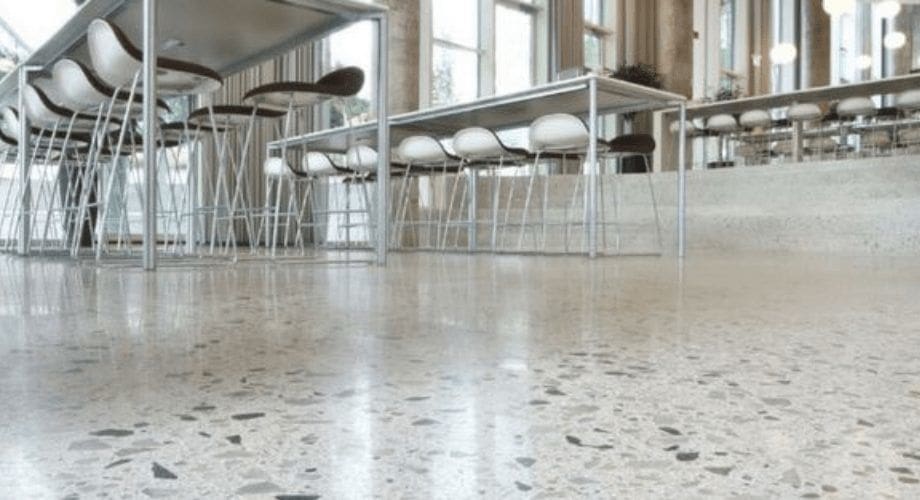

Polished Concrete Flooring: The Process
Once you’ve decided on polished concrete, you’ll probably want to know what exactly is involved. How long will the process take? What are some other things I should know before starting one of these projects?
You can think of the process of polishing concrete much like you would sanding wood. High-end polishing machines are used to grind the concrete’s surface. Instead of sandpaper, concrete polishing involves disks made of diamonds that achieve varying levels of smoothness and shine. Once the surface is at the desired gloss level, a polish guard is added and decorative touches are applied.
Depending on the size and scope of your project, your contractor will furnish various specialty equipment. Concrete floor grinders should be operated by experienced technicians. Planetary grinders, concrete milling machines, tile scrapers, shot blasters, concrete scarifiers, and dust collection systems may also be used on your flooring.
Some of the factors which can make a particular project take more or less time include:
- the substrate’s condition and amount of surface prep needed
- the amount and extent of patches and repairs required
- your desired aggregate exposure
- existing chips, cracks, and divots
- color choice and needed decorative elements
Many concrete flooring contractors will provide you with a consultation to learn more about what you need and provide you with more information that will help you budget for and schedule your project. If you are overseeing a polished concrete project, you’ll want to make sure to approve a mockup to make sure the color works for your space. You’ll also need to decide on a color for your joint filler and confirm that the finish and shine are suitable for your needs. At the end of your project, ask your contractor to provide you with gloss meter readings to ensure your flooring meets minimum gloss requirements. Having a solid project plan with carefully established expectations can help prevent any costly headaches during your project.
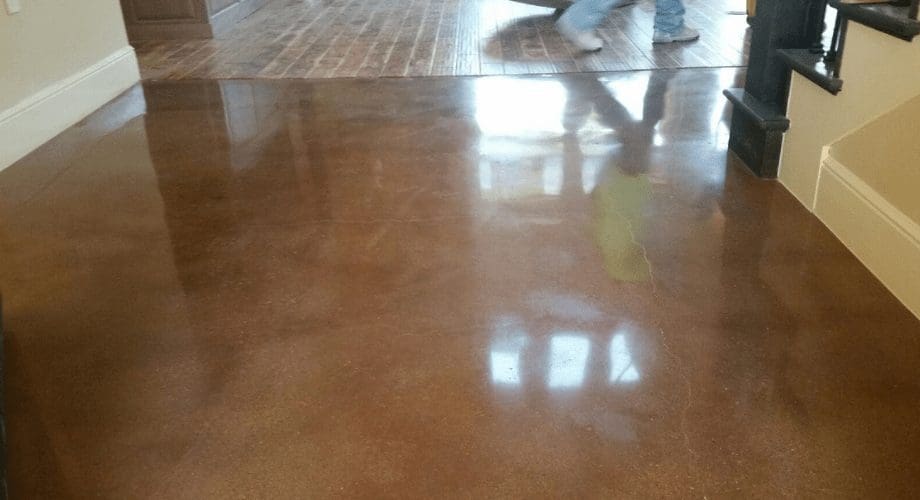

What Homeowners Should Know about Residential Polished Concrete Floors
In the era of do-it-yourself remodeling projects, ripping out carpet and polishing your own concrete floor may sound like a good idea initially. Similar to many other home projects, however, attempting to take on a concrete polishing project on your own may end in disaster. One of the biggest initial roadblocks is the specialized equipment you’ll need for the job. Not only are concrete grinders and polishers heavy and expensive, but they are also difficult to operate if you don’t know what you are doing. Then, you’ll have to decide what color, stain, dye, and other aesthetic elements you want to incorporate, which can be very difficult to choose from. In the end, your best option is to hire a pro for the job. That way, you’ll make sure your residential project is done right, the first time. You’ll also save yourself valuable time, especially if you start the job and realized in the middle that you’re in over your head.
AllStar is a Trusted Resource for Polished Concrete Flooring
Polished concrete projects require a unique combination of skills and expertise to ensure the finished product matches your design preferences. The skilled craftsmen at AllStar Concrete Coatings have decades of experience installing all types of concrete flooring systems in commercial settings, industrial facilities, and homes. Our expert decorative concrete contractors have built a reputation for exceeding client expectations. With AllStar working on your project, you can expect beautiful, high-quality results, on time, and within budget.
Free Consultation
Ready to learn more about how AllStar can help you? Take advantage of our free consultation to get the ball rolling.
Get Started
